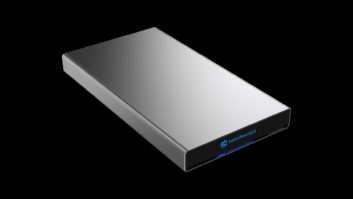
Microsoft delivers electronic content via its premium versions of Vista or Windows XP Media Center and a “Home Theater PC.”
The victorious afterglow of Blu-ray supporters may be fading fast as downloadable HD content steps in to challenge Blu-rays current supremacy.
While the best bargain in Blu-ray remains Sonys Playstation3 upgrade at $399, Microsoft has denied rumors that it will sell a version of Xbox 360 with a built-in Blu-ray drive. In disclaiming the rumor, Microsoft spokespeople have referred to downloadable content as the future of home video, as did Toshiba when it dropped HD-DVD. That makes sense, as Xbox 360 already offers access to a variety of downloadable content, including movies in both SD and HD. It may also serve as an extender to access content stored on other computers on the home network and play it back through the audio/video devices connected to the Xbox 360.
Similarly, when updated to the aforementioned 2.30 system software, the PS3, with the Cell processor co-developed by Toshiba with Sony and IBM, is positioned to download more than just games and Blu-ray movie trailers. Is a movie service far behind?
Microsofts Other Role
Microsoft also delivers electronic content via its premium versions of Vista or Windows XP Media Center and a Home Theater PC. Companies like HP and Sony in the mass market, and Niveus Media and others in the custom market, have products that fit into the main viewing room without disrupting the interior design, and all can be placed out of sight in equipment rooms. Consumers may acquire, store, manage, and play content directly from the computer to a display and sound system, or use an Xbox 360 or HP MediaSmart video display as an extender, all without touching an optical disc.
Add the growing array of hardware products that acquire, store, manage, and play back movie content to content aggregation and transaction services, such as CinemaNow, MovieLink, Amazons Unbox, and MovieGiants, and one can easily see a future where physical packaged media begins to lessen in importance for movies and other motion video content.
New Delivery Pipes
Many more conduits are due to open up soon to provide content directly to consumers without a physical disc. Wireless carriers are already providing video content to cell phones, and with spectrum space freeing up early next year, services are in the works to send content to a new range of devices nationwide. Similarly, plans are afoot for broadcasters to send content to mobile and handheld devices within their digital broadcast.
Finally, dont count out the telcos. Both Verizon with their FIOS service and AT&T with U-verse have the ability to deliver on-demand content directly to homes in addition to traditional linear program services from broadcasters and the cable and pay networks.
Does all of this mean that physical video media is in its death throes? Of course not. The enormous worldwide library of movie and video content created over the last 100 years vastly outweighs the capacity of any electronic deliver service to offer it on demand. Think about the titles once available on videocassettes that are still not available on DVD. Add to that the tiny percentage of titles that are available on Blu-ray due to the costs of re-mastering, re-authoring, and replication in relation to the size of the market for a given title. Even under the best of circumstances, it could be years before anything other than the most popular back-library titles make it to Blu-ray.
In the long run, Blu-ray may win with mass appeal titles, once player costs drop to the magical $99 price point, but that wont be happening very soon. At the same time, DVD isnt going away. Then, given sufficient delivery bandwidth, more effective compression schemes for both audio and video (e.g., H.264/MPEG-4 and others) electronic delivery will begin to creep up as a way to watch what you want, when you want to watch it.
IPTV as Long-Term Victor
Devices to access content stored on a computer or NAS on a home network are available, and their number is growing. At the same time, dedicated video server devices, either pre-loaded with content from physical discsas many installer/designers do today with products such as Kaleidescapeor electronically from content services such as MovieGiants, can send video content. However, all of these products depend on content that is already pre-loaded on the storage device. What happens when your client wants instant access to a library of movies, music videos, TV shows, and specialty programming that isnt readily available?
That is where IPTV-based devices come into play as the vanguard in a fight for market share between physical delivery and electronic deliverydevices that, without any intervening computer, allow the end user to view a wide selection of content, see the electronic equivalent of back of the jacket notes, and (hopefully) instantly watch the movie with the push of a few buttons on a dedicated remote.
Hands-On Review
There are two products at the forefront of electronic delivery today. Vudu and AppleTV are both small and are available for under $300. Each stores up to 50 hours of SD content on their internal hard drives, and offer HDMI, component video and S/P-DIF digital audio connectivity, with graphical interfaces that show cover art and drill-down metadata. Both offer, in most cases, the ability to see a trailer or preview before purchase.
To provide a level playing field for the content access speed comparison, both products were used in my home network, through a cable modem with typical download access speeds in excess of 5.5 Mbps. To eliminate any pipe issues, both were connected to the cable modem behind products supplied by Netgear, including a 1 Gbps router to the cable modem, and their latest WNHBDED-11 Wireless N Networking Kit. By using the 5Ghz N band, there is no chance that system speed will be dropped when Mom uses the laptop with b/g wireless that she brought home from the office.

When it comes to systems integration, rather than standalone use, Vudu clearly stands out.
When it comes to systems integration, rather than standalone use, Vudu clearly stands out. It has a standard RF remote, making it easy to use even when the remote cant see the unit. The remote fits nicely in the hand with four control push buttons, a power on/off toggle, and a scroll/push wheel for most system navigation. By comparison, the AppleTV comes with a small IR remote that works well, but is an ergonomic nightmare.
Where Vudus control shines, however, is its IR capability for integration of the Vudu codes into a learning or programmable remote. Beyond that, however, both Vudu models offer networked IP control, so that where a grander scale keypad or control is in use, integration is a much easier task. As an example, NetStreams already offers integration of the new 1TB Vudu XL model with its DigiLinx systems for both control and program distribution via IP throughout a home system.
In terms of audio and video, it is somewhat hard to compare the quality of Vudu vs. AppleTV, due to the variation in the original source material and mastering from one title to another. Both had some titles that looked splendid, and some that looked average. AppleTVs content is specd up to 1280×720/24p, while Vudu claims content availability up to 1080/24p. Both offer titles in HD with Dolby Digital 5.1 sound, but for those hankering for the of the latest lossey and lossless audio codecs from Dolby and DTS, youll have to point your clients to Blu-ray.
What About Content?
Content is one place where there are differences between Vudu and AppleTV. Some titles appear on both services, while many only appear on one or the other. Vudu is a better choice for those looking for foreign content, particularly with its wide variety of Bollywood titles. Vudu also seems to have older, off-beat content, like the cult classics Attack of the 50 Foot Woman and Plan 9 from Outer Space.
Vudu and Apple TV both also have movie rental systems that provide SD and HD titles. The end user can download a title with the familiar stipulation that it is must be viewed within a month, and once viewing has begun, must be completely within 24 hours. Pricing per title gives a bit of an edge to AppleTV with HD content at $4.99 or $3.99 for older movies and SD titles at $3.99 and less. Vudus HD titles rent for $5.99, and their SD titles for $3.99 to $0.99and in the case of some promotions, there are even free rentals.
The difference between the two is that Vudu offers titles to own, as well as to rent. In fairness, Apples iTunes store offers a purchase option for many titles, and AppleTV does allow you to access content that you have bought on your computer. However, in situations where the AppleTV is installed without connection to a computer with purchased content, it is rental-only at this time.
When it comes to navigating through the products available content, Vudu comes out ahead. Both systems offer crisp, high-resolution artwork, but Vudus interface makes it much simpler and more fun to select a movie by breaking down titles into groupings and displaying cast and creative credits with one title click. AppleTV allows search by title and other typical criteria such as genre, but the main listing is a flat alphabetical display of titles. But For Vudus easier organization of movie content, it is, for the moment, a video content product only.
On the contrary, AppleTV shines in its ability to access both audio and video podcasts to enjoy via the rooms big system, rather than on an iPod and headphones, or small speakers. Even better, AppleTV brings YouTube to your big screen. That, alone, could be worth the price of admission to some in the increasingly hot world of user-generated content.

AppleTV shines in its ability to access both audio and video podcasts to enjoy via the room’s “big” system.
A final important point of comparison is download speed. Given 2Mbps, both systems offer fairly instant playback of rented (or, in the case of Vudu, purchased) content. With 4Mbps, Vudu claims instant HDTV program availability, with anything less than that requiring some wait for a download. My non-scientific test showed that Vudu was able to deliver on the promise of instant HD, and they even have a system speed test menu and front-panel indicator that lets you know what to expect. As with any download system, you cant fast forward right to the middle or end of any content you are viewing, as the system needs to get a view ahead buffer of data recorded on the hard drive before the point in the movie you are watching.
It could possibly be our system, but given access to the same networking configuration, AppleTV was unable to deliver anything approaching instant access to HD downloads. In one instance, in the case of a short HD podcast, it took longer to download and buffer the content that it did to view it. In one instance, a short HD podcast took longer to download and buffer than it did to view the content. Whether this was the local network, server-related or due to ISP issues, this might not be a product for those with Type A personalities.
Does the current crop of IPTV products present such a compelling case that Blu-rays seeming win isnt real? For HD content, certainly not yet, particularly when the requirement is to show the absolute best in audio and video. Due to hardware and network limitations, neither AppleTV or Vudu can deliver on that score. On the other hand, both units certainly show that, in the long term, successor models, or new products and brands yet to appear, will have the ability to compete with optical players.
Michael Heiss ([email protected]) is technology consultant based in Los Angeles, California.







